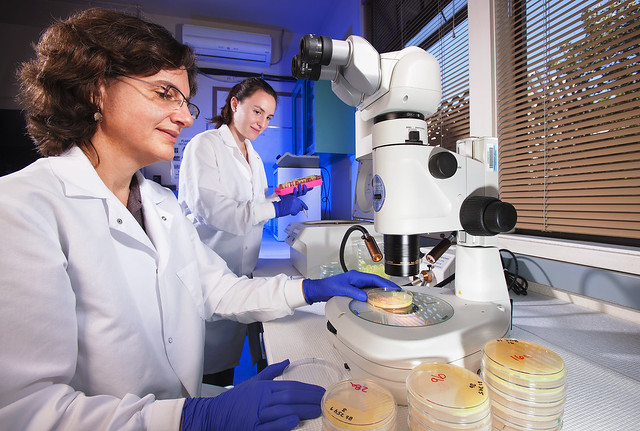
Scientists from USDA developed the tools to mass produce penicillin, which was used for treating wounded soldiers over 70 years ago during World War II. Antibiotics are still important in treating microbial infection in humans, animals, and plants. However, microbes can develop resistance to some antibiotics, making them less effective. USDA agencies continue to work on numerous issues related to antibiotics and antimicrobial resistance (AMR).
USDA’s Food Safety and Inspection Service (FSIS) is an active participant in a collaboration called the National Antimicrobial Resistance Monitoring System (NARMS). This collaborative program helps FSIS to monitor and understand the emergence, persistence, and spread of antibiotic resistance in food-producing animals. FSIS focuses on testing samples collected from animals at slaughter, while the U.S. Food and Drug Administration (FDA) monitors retail and poultry food products, and the Centers for Disease Control and Prevention (CDC) monitors ill humans.
The Animal and Plant Health Inspection Service Veterinary Services (APHIS-VS) addresses antibiotic use and AMR in food animals through studies on farms and in veterinary clinical settings. In 2017-18, its National Animal Health Monitoring System (NAHMS) conducted AMR studies at cattle feedlots, swine operations, and cow-calf feedlots. Its National Animal Health Laboratory Network coordinated a pilot project that tested animal pathogen isolates at veterinary clinics to assess resistance to antimicrobials. The National Veterinary Accreditation Program provides publicly available online education on antimicrobial use and AMR for veterinarians and food animal production workers.
The Economic Research Service (ERS) studies trends and emerging issues surrounding the use of antibiotics in agricultural production. This analysis helps public and private decision makers understand the economic decisions made by livestock producers and others involved in the industry, which can lead to more efficient policymaking, improved on-farm decisions about antibiotic use, and better public comprehension of producer behavior. ERS also examines how government programs that incentivize research and development of human drugs would work in the animal pharmaceutical market.
The Agricultural Research Service (ARS) currently supports 25 multidisciplinary research projects that study the emergence and distribution of AMR populations in different animal production settings. This work focuses on AMR in animal health, the development of new antibiotics and antibiotic alternatives, and the identification of mitigation strategies to protect food safety. Since 2017, ARS scientists have published 205 peer-reviewed articles about AMR and alternatives to antibiotics.
The National Institute of Food and Agriculture (NIFA) has invested more than $30M since 2013 to support transdisciplinary systems-based research, education and extension projects on AMR across the United States. NIFA grantees further extend AMR knowledge and expertise by partnering and collaborating with colleagues at universities and colleges, in the private and public sectors, and in non-governmental organizations at the national and international levels.
USDA works every day to help provide better understanding of AMR and to develop science-based, “One Health” solutions to protect the American food supply from farm-to-fork. This allows the United States and the rest of the world to benefit from the use of antibiotics to cure human and animal diseases - now and for generations to come.
